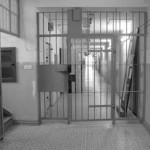On the last day of our trip a few of us went and toured the prison in which the GDR police placed citizens that posed a threat to communism. Our guide, who was once a prisoner here himself, reminded us throughout the tour that these buildings aren’t a recreation meant for us to observe and scare us, but instead these cells were used to hold thousands of inmates in horrible conditions. The prison was not only very eerie but extremely eye-opening. >Rachel Schilling ‘16<
We almost didn’t make it here because it’s out of the city and we got lost both trying to find it and trying to get back, but it was absolutely worth the trip. We did the German tour and understood a lot of it, and what we didn’t understand completely was explained well enough in bilingual plaques throughout the prison. This was probably my favorite part of the trip only because I had no idea that anything like this had occurred during the time of the wall, so it was incredibly eye-opening and interesting to hear all the stories of what happened in this prison. It is probably the thing I would most highly recommend next to walking through east side gallery on a trip to Berlin. >Katie Mooradian ‘16<
The German tours of the jail are conducted by old prisoners. My particular guide was arrested for taking a train that traveled too closely to the border of Western Germany and this gave them just cause for saying he was trying to escape. My tour guide was literally arrested for taking the wrong train at the wrong time… The interrogations, torture, and squalor living conditions weren’t able to be muted by my insufficient German. It’s quite shocking when you realize that this ended only 25 years ago and similar events take place daily throughout the rest of the world. >George DeRosa ‘16<
The time in the prison was not pleasant, nor was it meant to be. It began with a 30-minute film outlining the various types of cells used in the prison, the history of the prison, then stories about various prisoners. Our tour began with a soft-spoken man taking us through the Soviet-built older part of the prison. Right at the beginning of the tour, he told us that a State Security guard who would have been around twenty during the time that the newer section was built, if we met him today, would be “ungefähr so alt… wie ich.”//“…about as old… as me.” This intrigued me, and I started thinking about what role this tour guide could have in connection with this prison. When we visited the newer section of the prison, our guide revealed that he had been a prisoner! He had lived in East Berlin and had taken a train which travelled a route within five kilometers (about three miles) of the border to West Berlin. A State Security officer stopped him and convicted him of “a possible intention to attempt to cross into West Germany”, a clearly ridiculous crime. He was 18 at the time, younger than myself and any of the Dickinson students with whom I attended the tour. He had been imprisoned for 10 months on this charge until West Germany bought his freedom. At the end of the tour, he disappeared after saying “Ich würde vorschlagen, ihr macht noch heute etwas heiteres…”//“I suggest you do something cheerful today.” >Ezra Sassaman ’16<

